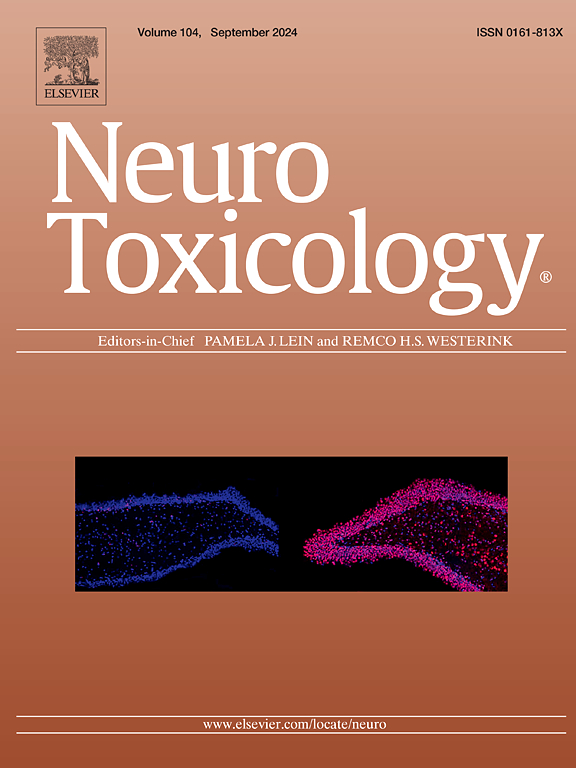Neuroprotective effect of Licochalcone A against aluminum chloride-induced neurotoxicity by reducing Aβ accumulation, oxidative stress and inflammatory reaction
IF 3.9
3区 医学
Q2 NEUROSCIENCES
引用次数: 0
Abstract
Excessive aluminum exposure is a contributing factor in several neurodegenerative diseases. Natural plant compounds such as Licochalcone A have been shown to have significant neuroprotective effects in vivo and in vitro. In this study, we aim to elucidate the neuroprotective effect of Licochalcone A against aluminum chloride-induced neurotoxicity and its possible mechanism. Adult zebrafish and PC12 cells were used as animal and cell models. Zebrafish and PC12 cells were treated with excessive aluminum trichloride (100 μg/L aluminum chloride hexahydrate solutions for zebrafish or 500 μM Al-malt solution for PC12 cells) to cause neuronal damage. The neuroprotective effect of Licochalcone A was evaluated by measuring ROS production, Aβ1–42 accumulation, inflammatory cytokines, neuronal apoptosis-associated genes, and MAPK pathway-related proteins to elucidate the mechanism of Licochalcone A against aluminum chloride-induced neurotoxicity. Licochalcone A effectively reduced the level of ROS production and inflammatory cytokines in both zebrafish and PC12 cells treated with excessive aluminum trichloride. In addition, Licochalcone A reduced the expression of BACE1 and generation of Aβ1–42 as well as the expression of p-JNK and MAPK, the key factor of the MAPK pathway. These results indicated that Licochalcone A has a remarkable neuroprotective effect against neurotoxicity induced by aluminum and has a high potential in the development of therapeutic drugs for neurodegenerative diseases.
甘草查尔酮A通过减少Aβ积累、氧化应激和炎症反应对氯化铝诱导的神经毒性的神经保护作用
过量的铝暴露是一些神经退行性疾病的一个促成因素。天然植物化合物如Licochalcone A已被证明在体内和体外具有显著的神经保护作用。本研究旨在阐明甘草查尔酮A对氯化铝诱导的神经毒性的神经保护作用及其可能的机制。以成年斑马鱼和PC12细胞为动物和细胞模型。用过量的三氯化铝(斑马鱼用100 μg/L六水氯化铝溶液,PC12细胞用500 μM Al-malt溶液)处理斑马鱼和PC12细胞,造成神经元损伤。通过检测ROS生成、A - β1 - 42积累、炎症因子、神经元凋亡相关基因和MAPK通路相关蛋白,评价Licochalcone A的神经保护作用,阐明Licochalcone A抗氯化铝诱导神经毒性的机制。Licochalcone A有效降低了过量三氯化铝处理的斑马鱼和PC12细胞中ROS的产生和炎症细胞因子的水平。此外,Licochalcone A降低了BACE1的表达和A - β1 - 42的生成,以及MAPK通路的关键因子p-JNK和MAPK的表达。上述结果表明,甘草查尔酮A对铝致神经毒性具有显著的神经保护作用,在神经退行性疾病的治疗药物开发方面具有很大的潜力。
本文章由计算机程序翻译,如有差异,请以英文原文为准。
求助全文
约1分钟内获得全文
求助全文
来源期刊

Neurotoxicology
医学-毒理学
CiteScore
6.80
自引率
5.90%
发文量
161
审稿时长
70 days
期刊介绍:
NeuroToxicology specializes in publishing the best peer-reviewed original research papers dealing with the effects of toxic substances on the nervous system of humans and experimental animals of all ages. The Journal emphasizes papers dealing with the neurotoxic effects of environmentally significant chemical hazards, manufactured drugs and naturally occurring compounds.
 求助内容:
求助内容: 应助结果提醒方式:
应助结果提醒方式:


